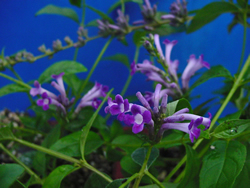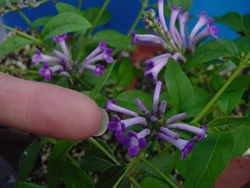Search
For The Answer
Click here to access our database of
Plant Answers
Search
For The Picture
Click here to access the Google database of plants
and insects
Information
Index
Alphabetical Listing of Topics, Recommendations
and Plants
Milberger's Nursery and Landscaping
3920 North Loop 1604 E.
San Antonio, TX 78247
210.497.3760
nursery@milbergersa.com
Open 9 to 6 Mon. through Sat.
and 10 to 5 on Sun.

Three exits east of 281, inside of 1604
Next to the Diamond Shamrock station
Please click map for more detailed map and driving directions.
=================================================================== Charles Bartlett wrote on December 10, 2006: I was very interested in your Sunday discussion of the new Buddleia which your team will offer for sale in 2007. I had first seen this evergreen Buddleia (Buddleia lindleyana) about 25 years ago in North Carolina, but had forgotten all about it and lost track of this shrub until recently. Several months ago, we began the re-landscaping of the old 41 acre property formerly owned by landscape architect Jim Keeter just south of Boerne, Texas on Scenic Loop Road. This Buddleia is growing (obviously planted by Jim) in areas around his home. The area is heavily wooded with mostly native species, quite shady, and home to herds of whitetail and Axis deer. The plantings seem to have been abandoned for many years (I'd say at least the last 10 years) and able to withstand acute drought and dense shade as well as full sun. Likewise, the deer seem to bypass this shrub, and it resists winter defoliation due to cold. One of the best descriptions of this plant is found in Volume 2, The Useful Wild Plants of Texas, the Southeastern and Southwestern United States, the Southern Plains, and Northern Mexico. Authors are Scooter Cheatham and Marshall C. Johnston with Lynn Marshall. From Volume 2, I quote: "Buddleia lindleyana Fort. (butterfly bush) is a native of China, but has been cultivated extensively in the southern United States, where it has escaped and naturalized in cultivated ground and along roadsides in the Coastal Plain from southeastern Texas east to Florida and Georgia. This is a diffusely branched shrub to 2 meters (6.6 feet) tall, with four-angled branches. The glabrous leaves, up to 1 dm (4 inches) long, are ovate to lanceolate, acuminate, and entire to remotely denticulate. The flowers are in upright and rather dense spikes up to 2 dm (8 inches) long. The corolla is purplish to violet or reddish and about 15 mm (0.6 inch) long, the tube being slightly curved. The seed capsules are 4-5 mm (0.16-0.2 inch) long. It flowers summer through fall. The species is presumably named after John Lindley (1799-1865), a professor of botany in London and editor of Edward's Botanical Register. Synonym: Adenoplea lindleyana (Fort.) Small." Volume 2 indicates that the shrub is also extensively found in both North and South Carolina as well as Florida and Louisiana. Due to the extreme drought resistance of this shrub, it's obvious deer resistance, evergreen nature, almost constant blooming period (it's blooming now in December), insect and disease resistance shown by the plants in Boerne, and ability to take care if itself, I believe that this will be an outstanding 'new' plant introduction in Central Texas. It might also be enjoyed by gardeners as far North as Dallas as shown by its cold tolerance in the inland, highland areas of North and South Carolina. In the rocky soils of Boerne, the tendency to sucker is not very obvious, but even so, I believe that the good points of this shrub far outweigh the negative aspect (suckering). It also seems to be extremely easy to transplant (even bare root in the midst of summer) and easy to root as cuttings. The actual correct spelling of the name is in dispute. I wrote
Greg Grant for his opinion. Greg replies: Technically Buddleja,
apparently. -GG During a recent discussion of the B. lindleyana, you mentioned
that the cuttings you are growing came from a specimen in Seguin
which may have flower clusters longer than 5 inches. If that is
the case, we may be in great luck! Charles M. Bartlett ======================================= BUDDLEJA: "The spelling 'Buddleia' is often seen for this
genus (named after CULTIVATION: "Buddlejas prefer full sun and good drainage,
but thrive in any Buddleja lindleyana: Occurring wild in southeastern China, this
rather Reference: Botanica--The Illustrated Encyclopedia of Over 10,000
Garden Plants |





